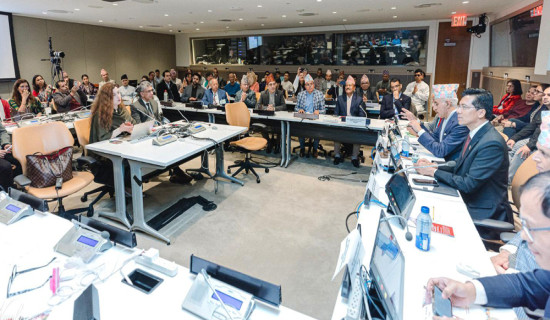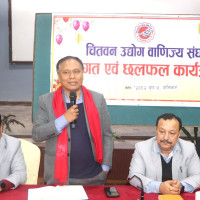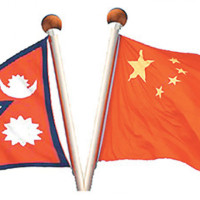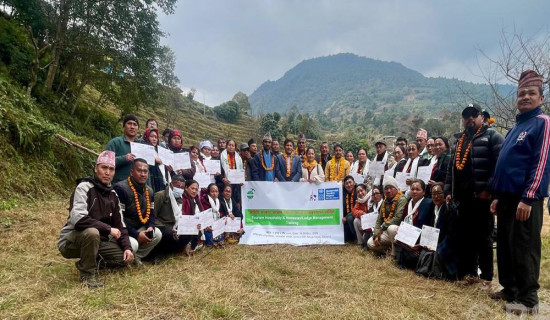- Sunday, 21 December 2025
Khijidemba Capitalising On Its Huge Tourism Potential
Although Okhaldhunga is a hilly district, some of its areas offer a spectacular view of nearly 80 per cent of the country’s high mountains, along with numerous green hills, valleys, and beautiful villages. Lying to the northwest of the district, Khijidemba Rural Municipality possesses infinite tourism potential. This area shares its borders with Pikey Peak, Lamuje, Bulbule, and Dhap areas of Solukhukhumbu district to the north. Another scenic place located close to Khijidemba is Pattale.
With the operation of regular bus services between Kathmandu and Khiji Phalante, it has become easier for travellers to visit Khijidemba and its surrounding areas. Visitors can also use their own vehicle or hire a jeep to reach there. Another option is that they can travel by bus or jeep up to Dhap in Solu Dudhunda Municipality and descend to Jhapre, Tolu Gumpa, and Phapre. Buses and jeeps are in operation between Salleri of Solukhumbu, and Kathmandu through Okhaldhunga Bazaar. A rough road also connects Jiri of Dolakha with Khijidemba via Shivalaya, Deurali, Bamti Bhandar, Goli, and Taklung.
Exotic Destination
Depending upon their time and interest, travellers can spend five to seven days in and around Khijidemba. Visitors to this exotic destination can also extend their trip to Pikey Peak, Phaplu, Junbensi and Dudhkunda. Those who have the time and energy to experience a longer trek up to Sagarmatha Base Camp may travel along the Tenzing-Hillary trail. Before the construction of the Lukla Airport, trekkers and climbers had no alternative but to use the Tenzing-Hillary trail. Built in 1964 under the supervision of the late Sir Edmund Hillary, the Lukla Airport (now renamed Tenzing-Hillary Airport) has proven to be a game changer when it comes to the development of tourism in the Khumbu Region.
As the sole route to Sagarmatha, that popular trail used to be crowded with foreign trekkers and Nepali support staff in spring and autumn. However, with a significant rise in the number of planes and helicopters flying to and from Lukla and the gradual extension of roads, the Tenzing-Hillary trail, which was once a famous route, now rarely witnesses trekkers.
With increased road accessibility and promotion, Khijidemba and its surrounding areas seem to have become an alluring tourist destination. Despite having unmatched scenic beauty and cultural diversity, these areas did not see any surge in the number of tourists for nearly three years owing to COVID-19. Together with the waning of the pandemic, tourism activities in these areas have now started resuming steadily. Local teahouse operators say that the number of domestic as well as international travellers visiting there has been going up considerably.
As Khijidemba is home to diverse communities such as Kshetris, Brahmins, Rais, Tamangs, Gurungs, and Sherpas, visitors can have the opportunity to become familiar with the culture and lifestyle of those peoples. This area could also be appropriate for researchers, especially college and university students, to carry out socio-cultural studies. With many herbs and other floral species, researchers could find the area to be apt for carrying out botanical research as well.
This rural municipality also possesses an airport. Though Tara Air, a private airline, successfully conducted a test flight at the Khiji Chandeshwori Airport in December 2019, the airport has yet to come into commercial operation. The airport is situated at a height of 2,070 metres above sea level. It takes just 22 minutes for an aircraft to cover the distance between Kathmandu and Khijidemba. The airport has been constructed with the combined efforts of the local and provincial governments. Once the airport comes into operation, it could help boost the tourism industry of the entire area. More Nepalis are expected to travel to this area.
The airport could also be used as a transit point to fly to Lukla from Kathmandu. As Kathmandu’s air traffic always remains congested, several domestic airlines use the airport at Manthali as a transit airport to operate flights to and from Lukla. Tourists face inconveniences when flights from Ramechhap get disrupted by the unavailability of adequate accommodation facilities there. Having about a 1,200-metre long runway, the Khiji Chandeshwari Airport is much bigger than the Ramechhap Airport. When the runway of the Chandeshwori Airport is expanded by 300 metres, even 72-seater ATR aircraft can land there. In view of such an enormous prospect, the concerned authorities now need to work towards bringing this airport into operation as soon as possible.
Given the huge tourism prospects of Khijidemba, the local government has accorded high priority to tourism development. It has joined hands with some Nepali golf players to develop Demba Danda, which is situated at an elevation of 3,360 metres above sea level, and other nearby places into natural golf courses. In November 2022, a test golf match was organised there to explore the potential of this area for golf. Blessed by nature, Demba Danda is famous for having a panoramic view of mountains as well.
"Apart from Demba Danda, there are some more hills suitable for trekkers to trek and play golf. The players can complete an 18-hole golf tournament in three days," says Gambu Sherpa, Chairman of Khijidemba Rural Municipality.
Sherpa believes that the promotion of the golf course could support local tourism. Many golfers, trekkers, and other nature lovers are expected to visit this part of the country after it is promoted as the world’s highest ‘Golf and Trek’ destination.
When the weather is clear, one can view as many as almost all the highest peaks from Demba Danda itself. Five districts—Okhaldhunga, Ramechhap, Solukhumbu, Dolakha, and Sindhuli—can be seen from this hill. This was also among the 100 potential tourist destinations the government of Nepal had specified for the promotion of Visit Nepal Year 2020. The government had aimed at developing transportation and other basic facilities in those destinations in order to facilitate tourist visits there.
"We are committed to developing this area into an important destination for adventurers and those interested in nature and culture," says Sherpa.
Wildlife Tourism
Wildlife tourism is another important segment of the area. The Gauri Forest (a dense forest near Khiji) is a habitat for red pandas. A lot of wildlife lovers could choose to visit this area, provided this endangered species is protected successfully. This dense forest may also be a haven for those interested in watching birds and butterflies.
This area also holds much religious significance as there are both Hindu and Buddhist pilgrimage sites such as Halesi Mahadev Sthan at Khiji, and the natural statue of Padma Sambhav (Rimpoche) at Tolu Gompa nearby Tolu.
The Pokali Waterfall is another tourist draw in the area. The 130-metre high fall is regarded as the second tallest waterfall in the country after the Hyatung Fall that lies in Tehrathum district. Located between Khijidemba Rural Municipality and Likhu Rural Municipality of the district, the Pokali Waterfall was also recognised as one of the top 100 tourist destinations for the Visit Nepal Year 2020. Visitors are bewitched by this waterfall. Many visitors experience canyoning in the spring season.
As part of highlighting the entire area at home and abroad, a full marathon is held every year. Okhaldhunga Tourism Development Committee, in collaboration with the local government and Nepal Tourism Board (NTB), organised the fourth edition of the marathon on March 2. A total of 70 participants, including 20 international players, took part in that adventure sport activity. Likewise, Pasi Sherpa Memorial Cup football and volleyball running shield events are also held in Khijidemba annually.
A documentary highlighting the myriad of tourist attractions the Khijidemba Rural Municipality has to offer is also being prepared. When the documentary is launched, it may help contribute to promoting the natural and cultural heritages of the area at home and abroad.
In April this year, a South Korean team led by the President of the Korean Alpine Federation (KAF) is planning to explore the area, which is suitable for trekking, cycling, marathon and paragliding. The area could be a potential destination for Korean trekkers. The local government is also planning to conduct a test flight of paragliding in October this year.
With an increase in tourism-related events and activities, the local people have begun opening lodges and guesthouses along the trekking trails.
Pasi Sherpa, the owner of Taklung Guesthouse, located at Taklung (3,500m), says that the disappearance of COVID-19 has brought high hopes to the locals with increased tourist arrivals.
"We have started receiving more foreign trekkers with the receding of the pandemic. Most visitors come here through Khiji and Dhap. Others get to this area via Pikey Peak," she says.
Breathtaking View
A breathtaking view of mountains, green hills, and villages is what entices tourists there. From Taklung, one can have a mind-boggling view of numerous peaks ranging from Sagarmatha, Mt. Amadablam, and Mt. Gaurishankar. Nearly 80 per cent of the country’s high mountains can be viewed from Demba Danda, Taklung, Pikey Peak, Dhap, and Pattale. But viewers need to use binoculars.
"The excitement of visitors knows no bounds when they visit Taklung and Pikey Peak areas as they can have an amazing view of many mountains, including Sagarmatha, in front of their eyes," she says.
Due to snowfall, the entire area appears white in the winter.But the area did not record snowfall this winter. However, the spectacular landscape enthrals everyone. In spring, the area turns colourful with the blooming of a variety of rhododendron species. During the Nepali New Year, the area welcomes a lot of domestic travellers.
"We are hopeful that we will get a chance to serve more domestic and foreign tourists this spring," she says.
Considering the negative impact of the haphazard opening of tracks and road extensions on the fragile local ecology, locals have started lobbying for stopping the construction of roads to Demba Danda and Pikey Peak. This is essential to maintaining the natural environment of these scenic places. With continuous road construction in the area, the existing trekking trails will either disappear or become shorter in the near future. So, it is imperative for the local government to maintain the existing trekking trails and develop new ones in order to keep attracting tourists to the area.
But what is more appalling is that illegal felling of trees seems to be widespread in the upper parts of this rural municipality, with trucks and tractors transporting a lot of timber logs to other parts of the country.
Ang Dorjee Sherpa, a tourism entrepreneur and social worker who hails from Phapre in Khijidemba Rural Municipality-9, calls for making the necessary efforts to preserve the environment.
Sherpa himself has planted thousands of trees on his land in Phapre in order to contribute to protecting the natural environment there. "Deforestation and timber smuggling must end. "If not, the area will lose its greenery, having devastating effects on the lives and livelihoods of the local people," he observes.
He suggests that eco-friendly lodges should be opened along the trekking trails to cater services to visitors. Homestay facilities should also be developed so as to offer accommodation and local cuisine to visitors. They could also learn much about the local culture and traditions.
Sherpa Hospitality
The Sherpa settlements in the area look much cleaner. According to Sherpa culture, they must not dispose of human excreta near home in order to make the god always happy. The traditional hospitality of the Sherpa community is so rich that they respect guests above anything else. Another tourism entrepreneur, Ngawa Ngima Sherpa, says that the area could be a preferred destination for both domestic and international travellers because it is becoming easily accessible.
"Though this is not a virgin area, the local culture is still alive. But the area has remained in the shadow. The area holds huge tourism potential considering the rich cultural and natural heritages," says Ngima, who is also a board member of NTB.
Khijidemba is also ahead of other areas in terms of agriculture as well. Indigenous seeds are still in use there. The local farmers do not use pesticides on their farms in order to produce organic products. With abundant water resources, the area has several hydropower plants. So, the local government has adopted the policy of promoting tourism, agriculture, and hydropower side by side in order to improve the local economy.
(Dahal is a deputy executive editor of this daily.)




-square-thumb.jpg)






-(1)-original-thumb.jpg)





